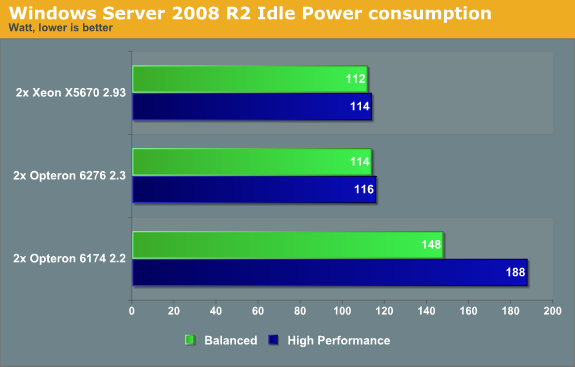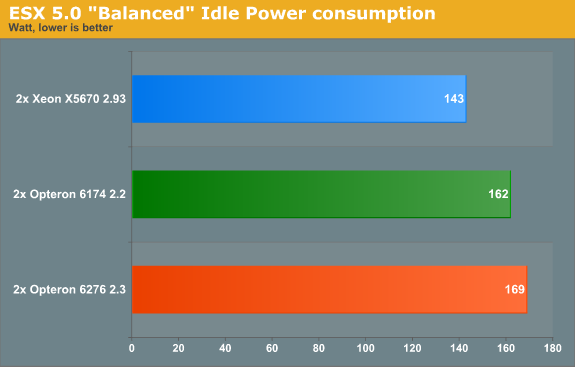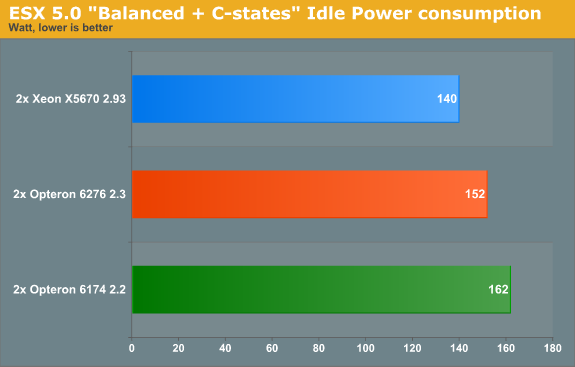Bulldozer for Servers: Testing AMD's "Interlagos" Opteron 6200 Series
by Johan De Gelas on November 15, 2011 5:09 PM ESTMeasuring Real-World Power Consumption, Part Two
First, we wanted to check if the Interlagos power management problems were specific to ESXi. Therefore, we measured the power consumption when running Windows 2008 R2 SP1 x64. We set the power management policy to "Balanced" and "High Performance".

Wow, that is a lot better! The core gating of the Bulldozer cores is first rate, as good as the Xeons of today. Idle power draw is a serious problem of the Opteron 6174: it is between 30 to 63% higher! So even if the ESX scheduler does not really understand how to handle the power management features of the "Bulldozer" Opteron, the question remains why the Opteron 6276 cannot even beat the Opteron 6174 when running idle in ESXi.

While I was testing the power consumption on Windows, my colleague Tijl Deneut dug up some interesting information about the ESX power manager. The Balanced Power policy (the default power policy for ESXi 5) is rather simple: it uses an algorithm that exploits only the processor’s P-states and C-state C0 and C1. So "Balanced" does not make very good use of the deeper sleep states. So we went for custom, which is the same as "Balanced" until you start to customize of course. We enabled the other C-states and things started to make sense.

After some tinkering, the Opteron 6276 does quite a bit better and saves 17W (10%). The Xeon reduces power consumption by 3W, and the Opteron 6174's less advanced power management is not able to save any more power. So enabling the C-states is an important way to improve the power consumption of the Opteron "Interlagos" with ESXi 5.










106 Comments
View All Comments
geoxx - Friday, December 9, 2011 - link
Sorry but neotiger is totally right, choice of benchmark sucks. We are not helped *at all* by your review.What company 32-core server is being used for 3D rendering, cinebench, file compression, truecrypt encryption??
You benchmarked it like it was a CPU of the nineties for a home enthusiast.
You are probably right pointing us to http://www.anandtech.com/show/2694 but your benchmarks don't reflect that AT ALL. Where are file compression, encryption, 3D rendering and cinebench in that chart?
Even performances per watt is not very meaningful because when one purchases a 2-socket or 4-socket server, electricity cost is not an issue. Companies want to simplify deployment with such a system, they want this computer to run as fast as a cluster, in order not to be bound to cluster databases which are a PAIN. So people want to see scalability of applications to full core count on this kind of system, not so much performances per watt.
Virtualization is the ONLY senseful benchmark you included.
TPC as suggested is a totally right benchmark, that's the backend and bottleneck for most of the things you see in your charts at http://www.anandtech.com/show/2694 , and objection on storage is nonsense, just fit a database in ramdisk (don't tell me you need a database larger than 64GB for a benchmark), export as block device, then run the test. And/or use one PCI-e based SSD which you certainly have.
http://www.anandtech.com/show/2694 mentions software development: how much effort does it require to set up a linux kernel compile benchmark?
http://www.anandtech.com/show/2694 mentions HPC: can you set up a couple of bioinformatics benchmarks such as BLAST (integer computation, memory compare), GROMACS (matrix FPU computations) and Fluent? Please note that none of your tests includes memory compares and FPU which are VERY IMPORTANT in HPC. Gromacs and fluent would cover the hole. Bioinformatics is THE hpc of nowdays and there are very few websites, if any, which help with the choice of CPUs for HPC computing.
For email servers (37%!) and web servers (14%) also I am sure you can find some benchmarks.
Iketh - Tuesday, November 15, 2011 - link
I'm not sure how the discovery of cores running in their power-saving state for far too long is anything new. My 2600k refuses to ramp up clocks while previewing video in a video editor even though a core is pegged at 100%. If I intervene and force it to 3.4ghz, preview framerate jumps from 8 fps to 16fps.This has been happening for YEARS! My old quad Phenom 2.2ghz did the exact same thing!
It's extremely annoying and pisses me off I can't benefit from the power savings, let alone turbo.
MrSpadge - Tuesday, November 15, 2011 - link
Sounds like you're running linux or some other strange OS, then. Or you may need a bios update. Generally Intel has its power management quit under control. In the AMD camp physical power state switches often take longer than the impatient OS expects, and thus average frequency is hurt. This was pretty bad for Phenom 1.MrS
Iketh - Tuesday, November 15, 2011 - link
win7 home premium x64 and the phenom was with xp 32bit... i haven't found another scenario that causes this, only streaming video that's rendered on-the-flyZoomer - Wednesday, November 16, 2011 - link
You have a 2600k and aren't running it at 4+ GHz?Iketh - Wednesday, November 16, 2011 - link
4.16 @ 1.32v when encoding, 3.02 @ 1.03v for gaming/internethaplo602 - Wednesday, November 16, 2011 - link
you do know that Linux did not have any problems with Phenom I power management unlike Windows ? Same is not with BD. Linux benchmarks look quite different from Windows and the gap is not that dramatic there.BrianTho2010 - Tuesday, November 15, 2011 - link
This whole review, the only thought I have is that there are no sandy bridge chips in it. When SB based Xeon chips come out I bet that Interlagos will be completely dominated.Beenthere - Tuesday, November 15, 2011 - link
Not really. SB chips don't fit in AMD sockets. AMD's installed customer base like the significant performance increase and power savings by just plugging in a new Opteron 6200/4200.C300fans - Tuesday, November 15, 2011 - link
It will. 2x6174 (24 cores) perform quite similar to 2x6274(32 cores). WTF